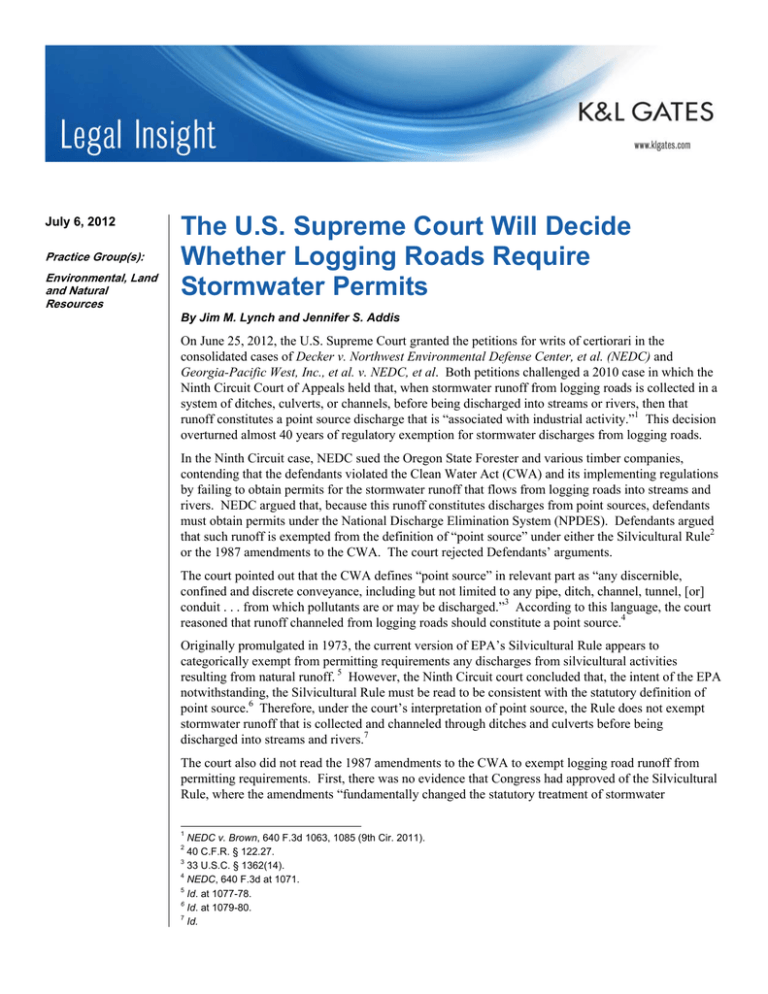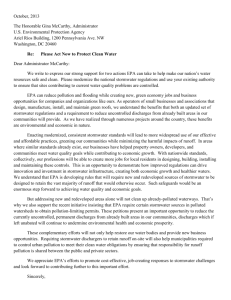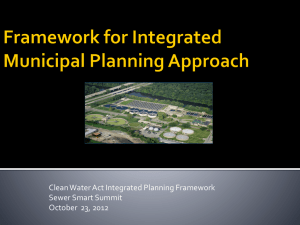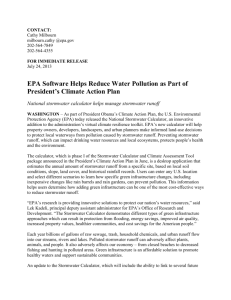The U.S. Supreme Court Will Decide Whether Logging Roads Require Stormwater Permits
advertisement

July 6, 2012 Practice Group(s): Environmental, Land and Natural Resources The U.S. Supreme Court Will Decide Whether Logging Roads Require Stormwater Permits By Jim M. Lynch and Jennifer S. Addis On June 25, 2012, the U.S. Supreme Court granted the petitions for writs of certiorari in the consolidated cases of Decker v. Northwest Environmental Defense Center, et al. (NEDC) and Georgia-Pacific West, Inc., et al. v. NEDC, et al. Both petitions challenged a 2010 case in which the Ninth Circuit Court of Appeals held that, when stormwater runoff from logging roads is collected in a system of ditches, culverts, or channels, before being discharged into streams or rivers, then that runoff constitutes a point source discharge that is “associated with industrial activity.”1 This decision overturned almost 40 years of regulatory exemption for stormwater discharges from logging roads. In the Ninth Circuit case, NEDC sued the Oregon State Forester and various timber companies, contending that the defendants violated the Clean Water Act (CWA) and its implementing regulations by failing to obtain permits for the stormwater runoff that flows from logging roads into streams and rivers. NEDC argued that, because this runoff constitutes discharges from point sources, defendants must obtain permits under the National Discharge Elimination System (NPDES). Defendants argued that such runoff is exempted from the definition of “point source” under either the Silvicultural Rule2 or the 1987 amendments to the CWA. The court rejected Defendants’ arguments. The court pointed out that the CWA defines “point source” in relevant part as “any discernible, confined and discrete conveyance, including but not limited to any pipe, ditch, channel, tunnel, [or] conduit . . . from which pollutants are or may be discharged.”3 According to this language, the court reasoned that runoff channeled from logging roads should constitute a point source.4 Originally promulgated in 1973, the current version of EPA’s Silvicultural Rule appears to categorically exempt from permitting requirements any discharges from silvicultural activities resulting from natural runoff. 5 However, the Ninth Circuit court concluded that, the intent of the EPA notwithstanding, the Silvicultural Rule must be read to be consistent with the statutory definition of point source.6 Therefore, under the court’s interpretation of point source, the Rule does not exempt stormwater runoff that is collected and channeled through ditches and culverts before being discharged into streams and rivers.7 The court also did not read the 1987 amendments to the CWA to exempt logging road runoff from permitting requirements. First, there was no evidence that Congress had approved of the Silvicultural Rule, where the amendments “fundamentally changed the statutory treatment of stormwater 1 NEDC v. Brown, 640 F.3d 1063, 1085 (9th Cir. 2011). 40 C.F.R. § 122.27. 3 33 U.S.C. § 1362(14). 4 NEDC, 640 F.3d at 1071. 5 Id. at 1077-78. 6 Id. at 1079-80. 7 Id. 2 The U.S. Supreme Court Will Decide Whether Logging Roads Require Stormwater Permits discharges,” and the statutory language was inconsistent with the Silvicultural Rule.8 Second, the court pointed to the amendments’ mandate that “discharges associated with industrial activity” require permits.9 The court reasoned that the logging activities fall within the type of “industrial activities” requiring permits under the CWA and its regulations.10 Therefore, the court held that neither the Silvicultural Rule nor the 1987 amendments exempt logging road runoff from permitting requirements when it is collected, channeled, and discharged into streams and rivers.11 In response, on September 13, 2011, a group of timber companies and industry associations, collectively “Georgia-Pacific,” as well as the Oregon State Forester and Board of Forestry, filed separate petitions for writ of certiorari with the U.S. Supreme Court. Georgia-Pacific argued that the Ninth Circuit Court improperly failed to defer to the EPA’s longstanding interpretation that stormwater runoff from logging roads does not constitute a point source requiring a NPDES permit under the CWA.12 The Oregon State Forester made similar arguments.13 Amicus briefs were filed by the National Association of Counties et al., the Alabama Forestry Association et al., the State of Arkansas et al., the National Alliance of Forest Owners et al., the American Forest Resource Council et al., and the Mountain States Legal Foundation, all of which supported the Petitioners. In a combined opposition brief, the NEDC asserted that the Court should deny certiorari because no circuit split existed and because the Ninth Circuit court’s decision presented no question of great practical importance.14 After considering the briefing in conference, on December 12, 2011, the Supreme Court invited the U.S. Solicitor General to file a brief expressing the views of the United States. On May 24, 2012, the United States filed its brief, recommending that the Court deny certiorari.15 Although the Solicitor General’s brief recommended the Court deny certiorari, it strongly supported the Petitioners’ position that the Ninth Circuit court’s opinion was wrongly decided. Specifically, the United States agreed with Petitioners that the Ninth Circuit erred by failing to defer to EPA’s interpretation of its own rules in two ways. First, under the Supreme Court’s Chevron decision, the Ninth Circuit was required to give deference to the EPA’s interpretation of its own Silvicultural Rule, unless that interpretation conflicts with the CWA.16 Second, the Ninth Circuit court wrongly ignored the EPA’s interpretation of its Phase I industrial stormwater regulations, which list the “industrial activities” that may be required to obtain NPDES permits.17 The EPA intended that phrase to include only those activities it had already defined as a point source elsewhere, which did not include logging activities. The Ninth Circuit disregarded the EPA’s intent when it held that “industrial activities” include logging operations. Yet despite these errors, the United States found no basis to recommend Supreme Court review of the case. Because no other court has addressed the question of whether forest roads are point sources 8 Id. at 1081. Id. at 1083 (referencing CWA § 402(p)). 10 Id. at 1084. 11 Id. at 1085. 12 Georgia-Pacific West et al. v. NEDC, Pet. Cert. 16. 13 Decker v. NEDC, Pet. Cert. 28. 14 Resp. Br. Opp’n. 15 Br. for the United States as Amicus Curiae [hereinafter “U.S. Br.”]. 16 U.S. Br. 11; see also Chevron U.S.A., Inc. v. NRDC, 467 U.S. 837, 841-44 (1984). 17 U.S. Br. 12–13; 40 C.F.R. § 122.26(b). 9 2 The U.S. Supreme Court Will Decide Whether Logging Roads Require Stormwater Permits under the CWA, no conflict exists among the courts of appeal.18 Moreover, the Solicitor argued that effective relief already is in progress, by virtue of Congressional and EPA action.19 As evidence of this progress, the United States pointed to the legislation passed as a rider to the budget appropriations bill last year, which suspends the permitting requirement through September 30, 2012.20 The Solicitor General characterized this legislation as providing “breathing space” for EPA to craft an administrative response to the Ninth Circuit’s decision.21 However, this position disregards the obvious likelihood that any attempt by the EPA to exempt logging roads from permitting requirements by rulemaking could be stymied by litigation almost from the start. Just the day before the Solicitor General filed its brief, the EPA published a Notice of Intent to revise its Phase I stormwater regulations to specify that stormwater discharges from logging roads are not “industrial activities” requiring NPDES permits.22 In addition to declaring its intent to revise its stormwater rules, the EPA also sought public comment with respect to possible approaches for addressing water quality impacts from forest road discharges. Perhaps in part due to the United States’ mixed messages in its briefing, the U.S. Supreme Court granted Petitioners’ request for a writ of certiorari on June 25, 2012.23 The Court consolidated the two cases, and oral argument on the case is likely to occur later this year. Though the Court’s motivation for granting the petition remains unclear, several reasons seem likely. First, from a practical standpoint, the Ninth Circuit’s holding may significantly impact private forest landowners and stateowned forest lands on which logging operations occur. Given the outpouring of support for Petitioners from the numerous states and associations that submitted amicus briefs, the Supreme Court could not help but be aware considerable public concern surrounding this issue. From a more legal perspective, the Ninth Circuit opinion represents a 180-degree reversal of one of the EPA’s longest standing regulatory interpretations. The EPA has viewed stormwater runoff from logging roads as non-point source in nature ever since it first promulgated the Silvicultural Rule in 1973. The EPA made its position clear early on, stating in 1975 that “whether or not the rainfall happens to collect [in ditches] before flowing into navigable waters,” that rainfall is properly regulated as “nonpoint in nature and should not be covered by the NPDES permit program.24 Throughout the last 37 years, Congress has acceded to this interpretation by never once correcting the EPA by statute. By adopting an unprecedented reading of the CWA, the Ninth Circuit court rejected four decades of EPA practice. At a listening session held in Seattle on June 27, 2012, the EPA indicated that it likely will move forward with its rulemaking regardless of the Court’s decision to accept review of the case. In advance of Wednesday’s listening session, EPA attorneys toured forest roads on U.S. Forest Service land and on private timber lands to observe BMPs in action. In his overview of the factors to be considered in the rulemaking and study of forest road stormwater management, EPA representative Jeremy Bauer acknowledged that research has demonstrated that when BMPs are implemented as intended, the effects of stormwater runoff from forest roads can be largely mitigated. He stated that the EPA recognizes that each state poses unique challenges to forest road stormwater management, and that going forward, EPA will consider flexible approaches that take into account this diversity. 18 U.S. Br. 14. Id. at 16–17. 20 See Consolidated Appropriations Act, 2012, Pub. L. No. 112-74, Div. E, § 429. 21 U.S. Br. 17. 22 77 Fed. Reg. 30473 (May 23, 2012). 23 Decker v. NEDC, Case No. 11-338. 24 40 Fed. Reg. 56932 (Dec. 5, 1975). 19 3 The U.S. Supreme Court Will Decide Whether Logging Roads Require Stormwater Permits Representatives of the timber industry as well as local and national environmental groups attended the session, offering their recommendations on the appropriate approach to federal forest road stormwater management. The EPA’s development of a forest road stormwater management strategy promises to be a lengthy, controversial process that will be well informed by the Supreme Court’s eventual ruling. Regardless of the reasons for the Court’s acceptance of the case, the Court has afforded itself an opportunity to clarify an area of law that will have immediate and profound consequences for thousands of landowners and millions of acres of forest lands. Authors: Jim M. Lynch jim.lynch@klgates.com +1.206.370.6587 Jennifer S. Addis jennifer.addis@klgates.com +1.206.370.8068 4








